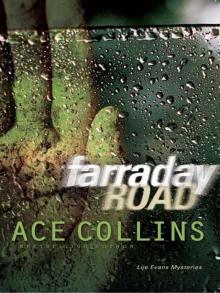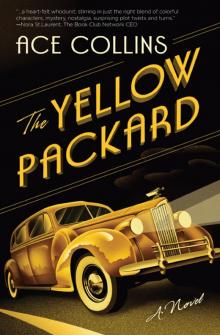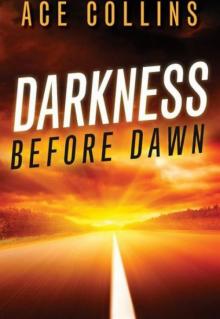- Home
- Ace Collins
Farraday Road
Farraday Road Read online
You are about to see a side of Ace Collins you have never seen before. In his first, and certainly not last, novel, old Ace picks you up and throws you right in the middle of an adventure on Farraday Road that you’re not about to forget anytime soon. Whether it’s history, nonfiction, or fiction, Ace Collins is at the top of his game. Don’t miss this one!
—Don Reid, The Statler Brothers
More twists and turns than an Arkansas mountain highway. Riveting from start to finish.
—Sierra Patricia Scott, TV news anchor,
host of It’s ALL Good! on KPTS-TV 8
Farraday Road invites the reader on a transcendent journey with each character as they unravel this high-stakes murder mystery.
—Laurie Prange, actress
Ace Collins weaves a spellbinding work of art in his first novel, Farraday Road, a thriller which chills, intrigues, and leaves you craving more.
—Emily Wierenga, journalist, author of Save My Children
Ace Collins continues to engage our minds and hearts with mystery and humanity.
—Dr. Rex M. Horne Jr.
I was gripped from the first page—an un-put-downable novel.
—Madeleine Morel, President, 2M Communications
Farraday Road quickly leads to the point of no return. Ace Collins directs readers down a winding path fraught with intrigue and excitement taken straight from today’s headlines.
—John Hillman, author, AP sports correspondent
Taut, inspired, and redemptive—Ace Collins’ world just won’t let you sleep.
—Evan M. Fogelman,
Sr. Intellectual Property and Entertainment Law Counsel
Farraday Road describes several fatalities, one of which is the idea that the past was a simpler time. Ace Collins is amazing.
—David Stricklin, Butler Center for Arkansas Studies,
Central Arkansas Library System
Other Books by Ace Collins
Turn Your Radio On:
The Stories behind Gospel Music’s
All-Time Greatest Songs
The Cathedrals:
The Story of America’s
Best-Loved Gospel Quartet
Stories Behind the Best-Loved
Songs of Christmas
Stories Behind the Hymns
That Inspire America
Stories Behind the Great
Traditions of Christmas
I Saw Him in Your Eyes:
Everyday People Making
Extraordinary Impact
More Stories Behind the
Best-Loved Songs of Christmas
Stories Behind the
Traditions and Songs of Easter
Stories Behind Women of
Extraordinary Faith
We want to hear from you. Please send your comments about this book to us in care of [email protected]. Thank you.
Farraday Road
Mobipocket Reader™ format
Copyright © 2008 by Andrew Collins
This title is also available as a Zondervan ebook.
Visit www.zondervan.com/ebooks.
Requests for information should be addressed to:
Zondervan, Grand Rapids, Michigan 49530
ISBN-13: 978-0-310-30061-8
Internet addresses (websites, blogs, etc.) and telephone numbers printed in this book are offered as a resource to you. These are not intended in any way to be or imply an endorsement on the part of Zondervan, nor do we vouch for the content of these sites and numbers for the life of this book.
All rights reserved. No part of this publication may be reproduced, stored in a retrieval system, or transmitted in any form or by any means—electronic, mechanical, photocopy, recording, or any other—except for brief quotations in printed reviews, without the prior permission of the publisher.
Interior design by Christine Orejuela-Winkelman
To Jane Davis Schaberg,
who was a bright light
in an often-dim world
Contents
Title Page
Copyright Page
Chapter 1
Chapter 2
Chapter 3
Chapter 4
Chapter 5
Chapter 6
Chapter 7
Chapter 8
Chapter 9
Chapter 10
Chapter 11
Chapter 12
Chapter 13
Chapter 14
Chapter 15
Chapter 16
Chapter 17
Chapter 18
Chapter 19
Chapter 20
Chapter 21
Chapter 22
Chapter 23
Chapter 24
Chapter 25
Chapter 26
Chapter 27
Chapter 28
Chapter 29
Chapter 30
Chapter 31
Chapter 32
Chapter 33
Chapter 34
Chapter 35
Chapter 36
Chapter 37
Chapter 38
Chapter 39
Chapter 40
Chapter 41
Chapter 42
Chapter 43
Chapter 44
Chapter 45
Chapter 46
Chapter 47
Chapter 48
Chapter 49
Chapter 50
Chapter 51
Chapter 52
Chapter 53
Chapter 54
Chapter 55
Chapter 56
Chapter 57
Chapter 58
Chapter 59
Chapter 60
Chapter 61
Chapter 62
Chapter 63
Chapter 64
Chapter 65
Chapter 66
Chapter 67
Chapter 68
Chapter 69
Chapter 70
Chapter 71
Chapter 72
Chapter 73
Chapter 74
Chapter 75
Chapter 76
Chapter 77
Chapter 78
Chapter 79
Chapter 80
Chapter 81
Chapter 82
Chapter 83
A COLD JUNE SHOWER PEPPERED THE WINDSHIELD of the cruiser. As Fulton County Sheriff’s Deputy Mikki Stuart drove along the narrow blacktop of a rural Arkansas highway, the slackening of the rain allowed her to relax. For hours the water had been beating against her car so hard the wipers couldn’t keep up—more than eight inches of heavy rain poured out of the skies onto the hills and into the streams. Finally she didn’t have to squint to see. It was the first time since noon she didn’t feel as though she was fighting a losing battle against Mother Nature.
It had been a day and an evening filled with drama and tension. During the last ten hours, Stuart had rescued two teenagers swept into Little Creek as they tried to cross a low spot on Highway 289, checked out three cars that had hydroplaned on wet pavement and spun into ditches, manned a flat-bottom boat to ferry four families out of treacherous floodwaters along Spring River, and inspected most every local bridge that was susceptible to being weakened by high water. Conditions were so bad she’d had to close six of the twelve bridges.
Now, at eleven o’clock at night, she was on her way to one last bridge inspection, on Burns Creek just outside of Union. The narrow iron bridge was a relocated Depression-era structure better suited for Model-A Fords than four-wheel-drive trucks. Though it was a relic from another age and presented a certain amount of danger for those crossing in foul weather, Stuart had put off inspecting “Old Iron” simply because the rural road it served led only to Farraday Cemetery. No burials had been scheduled there,
so she was certain no one would have used this unpaved county road unless the dead themselves had been washed out of their graves and were looking for higher ground.
The turn to Farraday Cemetery was hard to spot in daytime; at night it was almost impossible to find. As Stuart slowed to search for the weathered sign marking Farraday Road, she thought back to a time when the old bridge was easy to find, an era when it welcomed thousands of cars and trucks traveling Route 9 every day. Back then, in its original location spanning the meandering South Fork in Salem, the bridge had been on the most important highway in the area. As a child Stuart had traveled over Old Iron countless times, and each trip across the bridge seemed like a magical adventure. The bridge had a voice, groaning and creaking under each vehicle’s weight. It had a smell too, one of river water, fish, damp grass, and dogwood trees.
And then there was the view. Because there were no real walls along its sides, anyone who cared to look out their car windows could see all the way up and down the river. They could spot Miller’s Ford and Engine Bend, where, years ago, an Illinois Central train jumped the tracks and plunged into the clear waters below Nobb hill. Old-timers still spoke of that wreck as if it happened last week, and during low water, part of the rusty old locomotive could still be seen resting on the river’s sandy bed.
Now as she made her way back to Old Iron, all of the memories of her youth and this bridge came to life. She remembered how the pavement that covered its roadway often cracked after ice storms. She recalled watching canoes float under it and fish jump out of the water and splash back down. She remembered the feel of the water the time she leaped off the old structure. She was seventeen then, and Elijah Evans, a senior she’d been dating, had dared her to jump. Stuart kicked off her shoes, climbed up on the center railing, and jumped. Lije followed right behind her. That sophomoric escapade started a tradition. Soon jumping from Old Iron was a rite of passage for Salem High School seniors.
But as traffic increased on Route 9, the one-lane structure became a hazard, a bottleneck spawning numerous collisions and countless slowdowns. Truckers and local businessmen complained. Meetings were held. Heated debates followed. Still, everyone knew what the outcome would be: progress would win. Many of Salem’s most influential citizens fought to keep the bridge, embracing it as an important historical landmark. Campaigns were launched, petitions were signed, and even the governor came to talk at a rally about saving the old structure. But fifteen years ago, the state overruled the passionate citizens and logic trumped emotion. The bridge was replaced with a state-of-the-art concrete crossing.
Old Iron was removed, but a host of citizens would not allow the vintage bridge to be discarded onto the scrap heap. The memories spawned by the old bridge were simply too precious. So they raised money through raffles, donkey basketball games, and bake sales and saved the landmark, moving it fifteen miles from Salem to Farraday Road, where it replaced a low-water bridge on Burns Creek. Even though there was hardly ever a reason to go down that old road, many old-timers occasionally took Sunday drives over the span to reconnect with their past, and a new generation embraced the rarely used structure as a favorite parking spot on dates. It was a great place to watch the submarine races, they said.
As Stuart headed toward the bridge, she had no concern about the possibility of the structure collapsing. Over the past decades, every engineer who had examined Old Iron had declared that no flood could ever take it down. She knew it to be as solid as St. Peter himself. Old Iron was the unmoving rock on which they all could depend. Stuart was confident that long after every other bridge in the area had been torn down and replaced, Old Iron would be welcoming new generations of Arkansans. Still, the rain that had scoured the hills on this late June day surely would have transformed placid Burns Creek into a torrent of muddy water overflowing its banks and covering the bridge’s roadbed. If this was the case, Old Iron would have to be closed until the floodwaters receded. Except for those resting in the graveyard, no one would notice the roadblock on this ungodly wet night.
It was just past eleven when the deputy found the faded Farraday Road sign, turned her Crown Victoria squad car off Arkansas Highway 9, and directed it down the narrow muddy road leading to Old Iron. The rain had eased, almost stopped, and she switched the wipers to slow. The night was so dark it was difficult to see anything not illuminated by the car’s headlamps or by an occasional burst of lightning. Slipping along at twenty miles an hour, sometimes less, her tires tossing muck up high to both sides, Stuart strained to find the ruts she needed to hold her traction.
About a half mile from the highway, just as she cautiously directedthe car around a slight curve, something caught her attention. Stuart took her foot off the gas pedal. She avoided the brakes for fear of sliding and rolled to a stop in the middle of the road. She lowered the front passenger window and stared out into the blackness.
At first she thought her eyes, the night, the long hours she had worked had played a trick on her. She saw nothing but what should have been there—a mass of rain-soaked trees. The hill. She turned on her spotlight and pointed it into that area. Something out of place sprang out of the blackness to meet her. Almost hidden by a large mulberry bush was a late-model Ford Explorer. It appeared as if someone had taken the bend too quickly, lost tractionon the slick surface, slid off the road, and gotten stuck axledeep in the red clay. No different from the accidents she had dealt with earlier in the day. But something didn’t feel right. Seeing no signs of life in or around the vehicle, Stuart reached to her right, flipped on her emergency lights, and pulled her radio microphone from its bracket on the dash.
“James, you out there?”
Fulton County was small and the department was more like family than coworkers, so Stuart rarely used formal radio protocol. Sheriff Wood hated her laxness and had warned her repeatedly about following procedure, but Stuart, who usually played by the book, hadn’t changed. She employed the “legal” language when speaking to state troopers, but with locals she saw no reason to use anything but her native tongue, accent and all.
Stuart yanked her flashlight out from under the seat and slipped into her raincoat. A familiar voice greeted her through the radio speaker.
“Yeah, Mikki,” James Simpson called back, “ just pulled in to the courthouse. What do you need?”
“Got an SUV in the ditch not far from Old Iron, on the 9 side. Looks like the Explorer Lije Evans drives.”
“Be no reason for him to be out that way. Hasn’t been a burial out there in weeks. Must not be his. Car could’ve been there for some time. Probably a hunter got drunk and lost control. Anyone in it?”
“Not that I can see,” Stuart said, “but I’m getting out to check. Stay close. I’ll let you know what I find.”
“Okay.”
Stuart stepped out of the cruiser. As she sloshed through the mud, she became the consummate cop, carefully shining her flashlight all over and around the SUV, checking for signs of danger. She saw nothing even remotely threatening, but she still couldn’t shake the feeling that something was off.
She jumped across the water-filled ditch and directed her beam into the Explorer’s interior. A woman’s purse was on the front seat, a black leather briefcase was on the floor in the back, and a half-empty Coke bottle was in a drink holder. The key was still in the ignition. The car was unlocked. She carefully opened the passenger door; nothing unusual. After closing the door, she moved forward and touched the hood.
It was still warm.
Just another wreck, she tried to convince herself as she continued her inspection. She studied the area around the vehicle and spotted footprints leading up the slope to the right of the Explorer. If this was an accident, why would they try to go up the hill? Standing beside the Explorer, Stuart studied the prints more closely. Maybe they needed to get on top of the rise to get cell phone service.
Stuart’s years of hunting had taught her a great deal about tracking. There appeared to be at least four sets of footprints
on the hill. She tracked them back toward the car. She studied the ground on both sides of the SUV. Only two people had exited the vehicle. After flashing her light around the area, she discovered the other prints originated across the ditch, on the road, about ten feet in front of the Explorer. The stride length indicated all of these folks had been in a hurry. That washed the cell-phone theory. Stuart sensed that whatever she was investigating, it wasn’t just a minor accident.
Still standing beside the Explorer, she followed the jumbled footprints with her eyes as she moved her flashlight over the converging sets of tracks. It was obvious the trek up the hill had not been an easy one. There were numerous signs of slipping and falling, and Stuart noted a woman’s high-heel shoe stuck in the mud. Why would someone leave a shoe? Twenty yards up the rise, her light touched on something that looked like a piece of clothing, tan. Beyond that, the signs of panicked flight became even more obvious. When this crew blazed the trail up the hill, they left brokenbranches and ankle-deep holes in the wet soil, as if the ghosts of the cemetery were on their tails.
Twenty feet beyond where she had spotted the clothing, her light illuminated a haunting sight. Resting awkwardly on the muddy slope was a body, half hidden by a sycamore tree.
Stuart had been operating on hunches, and her hunches had been right. This was no simple mishap. She snapped off the flashlight and listened. Every sound seemed to signal a kind of danger that, as a rural deputy sheriff, she had never had to consider. Suddenly she felt vulnerable, and her fear sharpened her senses. She could hear Burns Creek, its channel full, rushing along the base of the valley. She heard the brush of her wipers against the windshield of the cruiser. She noticed a smell that hovered in the air like smoke. Why had she not noted it before? For the first time her nostrils filled with more than just the wet trees and ground; she caught a pungent hint of gunpowder. Startled, she gasped, and then she tasted it, and the taste of gunpowder turned her stomach. She almost retched.
Instinctively, from her years of training, Stuart crouched down by the Explorer and slid the flashlight to her left hand. Then she reached down and undid the snap on her holster. She pulled her pistol from its resting place and took a deep breath. Her heart was racing too fast, beating too hard; her lungs were burning; her eyes were seeing images, ghosts maybe, that were there one moment, gone the next.

 Stories Behind the Best-Loved Songs of Christmas
Stories Behind the Best-Loved Songs of Christmas Farraday Road
Farraday Road Yellow Packard
Yellow Packard Swope's Ridge
Swope's Ridge Darkness Before Dawn
Darkness Before Dawn